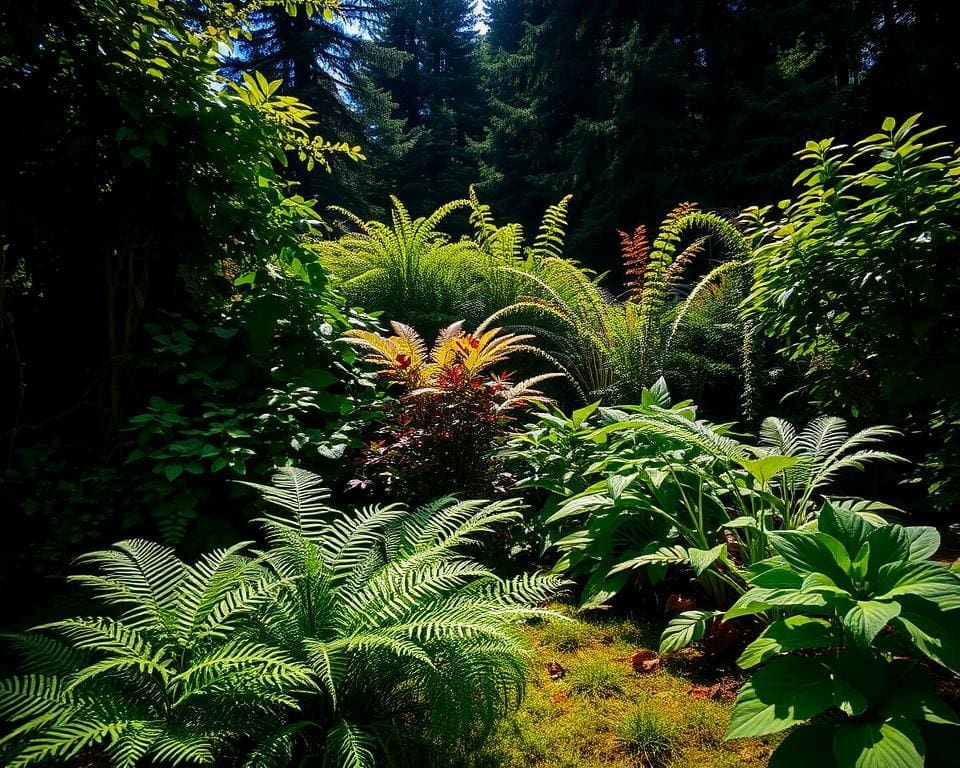Choosing the right plants for shady areas in your garden can transform these often overlooked spaces into vibrant havens of tranquillity. While many gardeners perceive shade as a challenge, understanding the unique dynamics of light conditions is crucial for thriving garden plants. In the context of UK gardening, you’ll discover that even the shadiest spots can offer opportunities for lush landscaping. With the right approach to selecting plants and an appreciation for the beauty that can flourish in these environments, you’ll cultivate areas that are not only beautiful but also healthily diverse.
Understanding Shady Areas in Your Garden
Exploring the dynamics of shady areas within your garden unveils the intricate relationship between light and plant growth. Identifying the types of shade that are present can dramatically impact your gardening choices. Shady areas may vary from dappled sunlight filtering through leaves to full shade where sunlight rarely reaches. Understanding these distinctions will empower you to create a flourishing garden even in less-than-ideal light conditions.
Types of Shade
There are several types of shade to consider when planning your garden. Recognising these can help in selecting plants that thrive in specific light conditions:
- Dappled Shade: This occurs when sunlight streams through the tree canopies, providing a mix of light and shadow.
- Partial Shade: In this type of shade, plants receive some direct sunlight, usually for part of the day, making it suitable for a wider variety of species.
- Full Shade: These areas receive minimal light, often under dense canopies, making them challenging for most plants.
Effects of Shade on Plant Growth
The intensity and type of shade play a significant role in plant growth. In shaded areas, photosynthesis can be limited, affecting how plants utilise light for energy. Many species adapted to garden shade often feature broader leaves to capture more light. Moisture retention in shaded regions can vary, with some areas staying damp longer than others. Understanding how these factors influence your plants allows for better decisions, leading to a vibrant and healthy garden.
How to choose the right plants for shady areas?
Selecting the appropriate plants for shady gardens requires careful consideration of several factors. A thorough plant assessment ensures that your choices thrive despite limited sunlight. Understanding how to evaluate light levels, soil conditions, and moisture requirements can significantly enhance the success of your shaded spaces.
Assessing Light Levels
Light levels fluctuate throughout the day, making it essential to monitor how shade impacts your garden. Observe the areas during different times to determine whether they fall into categories such as deep shade, partial shade, or dappled light. This assessment guides the selection of plants suited to specific light conditions, ensuring optimal growth.
Soil Conditions and Moisture
Understanding soil conditions is vital for promoting plant health in shady gardens. Conduct tests to determine pH and moisture levels, which affect plant vitality. Amending soil with organic matter enhances drainage and nutrient content, further supporting moisture requirements. Consider incorporating compost or well-rotted leaf mould to improve soil quality, fostering an environment where selected plants can flourish.
Top Plants for Shady Areas
Transforming shaded spaces into lush landscapes requires careful selection of the best plants that thrive in low light. This section offers insights into three distinct categories of plants, each showcasing their unique advantages. From vibrant foliage to delightful blooms and resilient ground covers, the options for shade-loving plants can enhance the beauty of any garden.
Foliage Plants
Foliage plants are crucial for adding texture and colour to shady areas. Varieties such as hostas and ferns are among the best plants for this purpose. Hostas, with their broad leaves in various shades, create a striking visual backdrop. Ferns bring an elegant, airy feel with their delicate fronds. Both require minimal sunlight yet flourish in well-drained, moist soil, making them ideal choices for shaded gardens.
Flowering Plants
For those seeking a splash of colour, flowering plants can indeed thrive even in the shade. Astilbe, characterised by its feathery plumes, offers stunning blooms in pink, white, and red hues, harmonising beautifully with the surrounding greenery. Hellebores, often flowering in early spring, add early-season interest and vibrant colours that can brighten up any shaded corner of the garden. These flowers not only add aesthetic appeal but also attract pollinators, enriching the garden’s ecosystem.
Ground Covers
Ground covers are practical solutions for filling in low-light areas and preventing soil erosion. Ivy, a classic choice, spreads quickly and offers an evergreen presence, while creeping phlox provides vibrant, dense blooms that create a delightful carpet of colour. These ground covers are particularly effective in shaded spaces, enhancing the overall visual impact while helping to maintain soil health and stability.
Designing with Shade Plants
Creating an inviting and beautiful garden space using shade plants requires a thoughtful approach to garden design. By layering plants effectively, one can achieve depth and visual interest while enhancing overall garden aesthetics. Tall plants can anchor the back of a border, and shorter varieties can fill in the front, resulting in a harmonious display.
Layering for Visual Interest
When designing with shade plants, consider incorporating a variety of heights. Start with taller plants such as hostas or ferns at the back. Place medium-height plants like astilbes in the centre, while ground covers such as creeping thyme can frame the front. This layered approach provides a sense of dimension, drawing the eye across your garden and adding rich visual interest.
Creating a Focal Point
Every garden benefits from a focal point that captures attention. Select striking shade plants, such as a bold Japanese maple or a vibrant rhododendron, to serve as the centrepiece. Garden features like a decorative bench or a sculptural installation can also act as focal points, enhancing the beauty of the surrounding shade plants. This strategy not only beautifies your garden but reinforces the importance of design in creating spaces that are both functional and visually compelling.
Maintenance Tips for Shaded Gardens
Shady gardens require a unique approach to garden maintenance to thrive. Understanding the specific needs of plants in these areas ensures lush growth and vibrant greenery. Emphasising watering techniques and the correct fertilisation regimen can significantly enhance the vitality of your shaded spaces.
Watering Techniques
Effective watering techniques tailored for shady gardens are crucial for maintaining healthy plants. Given that shaded areas often retain moisture longer than sunnier spots, caution is essential to avoid overwatering. Consider these practices:
- Check soil moisture levels before watering. Feel the top inch of soil; if it feels damp, wait a bit longer.
- Use soaker hoses or drip irrigation systems to provide deep, consistent watering without saturating the surface.
- Water early in the morning to minimise evaporation and fungal growth.
Feeding Shady Plants
Feeding plants in shaded areas requires careful consideration of the nutritional needs specific to their environment. Implementing a suitable feeding strategy promotes robust growth and flowering:
- Select slow-release fertilisers or organic options like compost and well-rotted manure to support long-term plant health.
- Avoid high-nitrogen fertilisers as they may encourage leggy growth, which is less suited for shaded conditions.
- Establish a regular feeding schedule, particularly during the growing season, to maximise plant potential.
Common Mistakes to Avoid
When embarking on the journey of gardening in shady areas, it’s crucial to steer clear of common errors that can hinder your plants’ growth. One of the primary gardening mistakes made is underestimating the type of shade in your garden. Not all shade is created equal; understanding whether it is dappled, part sun, or full shade will greatly affect your success in choosing plants. Failing to account for this can lead to poor plant selection and ultimately, disappointment.
Moreover, overlooking the mature size of plants can become another major pitfall. Many gardeners focus on the small beauties they pick out without considering how much space they will require as they grow. This can lead to overcrowding and inadequate light or nutrients. Effective shade plant care involves planning for the future, ensuring that the selected plants can thrive alongside each other without competing for resources.
Finally, the temptation to over-fertilise shaded plants is a common error that can wreak havoc on your garden. In low-light conditions, plants are often less active and require less fertiliser. Instead of a regimen of excess nutrients, gradual and moderate feeding will support the health and vibrancy of your shaded garden. By recognising these gardening mistakes, you empower yourself to adapt and flourish in shade gardening, creating a beautiful and thriving ecosystem in your outdoor space.









